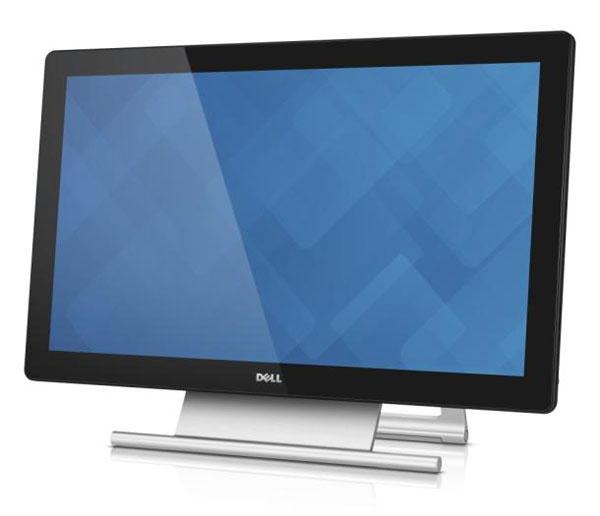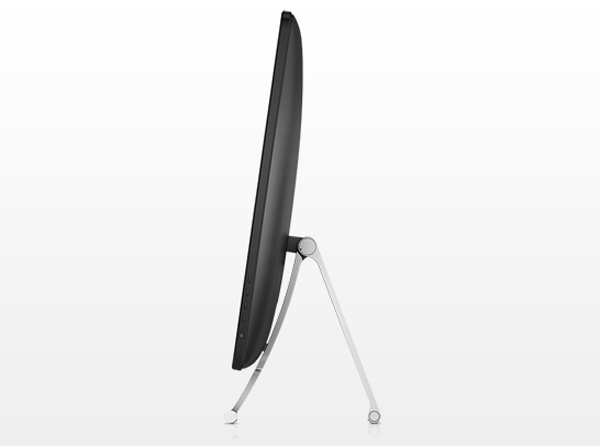Dell P2714T 27-Inch Touchscreen Monitor, Reviewed
If you're looking for the tablet-like experience on your desktop PC, Dell's P2714T could be the answer. This 27-inch multi-touch screen offers FHD resolution and sleek design at a high price point. But does its performance stack up in our lab tests?
Packaging, Physical Layout, And Accessories
The P2714T comes in a standard suitcase-style box with sufficient protection to withstand the rigors of shipment. HDMI and USB 3.0 cables come bundled, and the panel is kept slim by an external power supply. Dell includes the brick and a detachable cord. Rounding out the accessory package is a CD containing the user’s manual and drivers, a microfiber cleaning cloth, and a Velcro cable tie.
The panel seems very solidly put together. There isn’t the slightest hint of flex in any part. Given that a monitor like this is expected to get touched, prodded, poked, and perhaps even manhandled, beefy construction is a must if it's going to survive at least as long as Dell's three-year warranty period. Desktop displays typically aren't subjected to such abuse, so construction quality is an important new consideration. Dell’s has always been well above average, and this touchscreen is no exception.
Product 360
The front of the panel is a single sheet of glass. The black bezel is actually behind that, so it won’t interfere with touch interaction. In fact, one centimeter of the bezel is designated a swipe-in area, which is a wholly separate gesture from a swipe that only takes place on the viewing surface. This technique is used to pull out graphical drawers onto the screen, which can be used for a variety of functions. For more on Windows 8 and its available touch-based interactions, check out The Definitive Windows 8 Review And User Guide.
Controls are tucked around the lower-right side of the panel. You have to operate them by feel, though that shouldn't be a problem because a small graphic pops up when you press any key, denoting the function of each. You’ll see a photo of this on the next page.
From the side, the panel looks slim and smooth. The plastic back panel is a single piece of hard plastic that wraps around to meet the front glass. The stand is aluminum and sports integrated rubber pads that grip any surface. Its hinge is very stiff, which means the monitor effectively holds any position you choose. Obviously there is no height adjustment, but you can expand the stand backwards until the panel is almost horizontal.
This is the lowest you can go with the P2714T. You wouldn’t use a typical computer monitor like this unless you were replicating Dillinger’s desktop from Tron. For a touchpanel however, this position can be very useful.
If you find the included stand too limiting, you can remove it to expose a 100 mm VESA mount.
Get Tom's Hardware's best news and in-depth reviews, straight to your inbox.
Inputs face downwards and include DisplayPort, two HDMI connections, and VGA. The USB 3.0 upstream port must be connected to enable touchscreen functionality. The two downstream ports on the back operate at USB 2.0 data rates, while the two side ports are third-gen-capable. The audio line-out jack is for use with speakers only; it does not support headphones. Audio input is enabled via DisplayPort or the HDMI interfaces. Speaking of HDMI, it's MHL-compatible, which means you can display the content from your phone or tablet on the P2714T. And the ports will charge your device whenever it's connected.
Connecting the P2714T is a plug and play affair in both Windows 7 and 8. Simply attach a video cable (we used DisplayPort) to your graphics card and the bundled USB 3.0 cable to an available port on your PC. After a quick reboot, you’re up and running with touchscreen functionality. Response to our gestures was fast and smooth with no perceptible lag. The touch layer's high resolution manifests in the fluid motion of on-screen objects and the ability to select very tiny buttons and text with precision. The glass doesn’t feel quite as slippery as an iPad, but it’s very close. And it resists fingerprints fairly well. Dell includes a small cleaning cloth in the box. If you use your own, make sure it’s of the lint-free microfiber variety.
Using such a large touchpanel is undeniably cool, but we still need to run through our standard calibration and benchmark tests before we get too carried away!
Current page: Packaging, Physical Layout, And Accessories
Prev Page Dell P2714T: A 27-Inch IPS-Based Touchscreen Monitor Next Page OSD Setup And Calibration Of The Dell P2714T
Christian Eberle is a Contributing Editor for Tom's Hardware US. He's a veteran reviewer of A/V equipment, specializing in monitors. Christian began his obsession with tech when he built his first PC in 1991, a 286 running DOS 3.0 at a blazing 12MHz. In 2006, he undertook training from the Imaging Science Foundation in video calibration and testing and thus started a passion for precise imaging that persists to this day. He is also a professional musician with a degree from the New England Conservatory as a classical bassoonist which he used to good effect as a performer with the West Point Army Band from 1987 to 2013. He enjoys watching movies and listening to high-end audio in his custom-built home theater and can be seen riding trails near his home on a race-ready ICE VTX recumbent trike. Christian enjoys the endless summer in Florida where he lives with his wife and Chihuahua and plays with orchestras around the state.
-
killerclick Lol touchscreens on the desktop, it was a crappy idea 2 years ago and it's a crappy idea now.Reply -
damianrobertjones @killerclick: That, of course, is YOUR opinion. I'd rather have the option than not have the option. Maybe we should just stop providing options... ."Having to lift your hand from the keyboard to reach out and touch your monitor definitely takes more time."So does moving your hand from the mouse back to the keyboard. As it stands I do actually prefer having touch.Reply -
damianrobertjones @killerclick: That, of course, is YOUR opinion. I'd rather have the option than not have the option. Maybe we should just stop providing options... ."Having to lift your hand from the keyboard to reach out and touch your monitor definitely takes more time."So does moving your hand from the mouse back to the keyboard. As it stands I do actually prefer having touch.Reply -
therogerwilco Don't talk to me about desktop monitors unless they have better resolutions than 1600p.Reply -
InvalidError @damian: having options may be nice but touch-screen on the desktop for everyday computing and productivity with touch as the primary input sounds like a horrible ergonomic disaster: to use a large touch screen, you need to bring it close to your waist to avoid excessive strain on your arms but putting the display there means having to hold your head at ridiculous angles to look at the screen which is going to strain your neck.So, touch on a large screen only makes sense for occasional/intermittent use.Reply -
killerclick Reply12389025 said:@killerclick: That, of course, is YOUR opinion. I'd rather have the option than not have the option. Maybe we should just stop providing options...
I said it's a crappy idea that's not going to catch on, and I'd prefer not to have to pay extra for it or sacrifice other aspects of the display, like resolution in this case. That said, the companies can put their R&D and marketing $ wherever they want, not my money, but it's still dumb.
-
Patrick Tobin After having used touch extensively on desktop, laptop and tablet form factors I have to say it works really well for a desktop system for quick hits and the such and getting in and out of stuff quickly in Windows 8, on a laptop it makes very little sense though. I would rather have it than not, but not at 1920x1080.Reply -
hannibal The childrens that are now using iDevices and similar can not live with traditional display if there are these in the market. In the long run non touchable monitors are gonna die out. Sooner or later there are more of those touch orientated customer than we old fossilised normal screen users... Eventually we die out and so will normal monitors. For me touch based pad with screen would be ideal for controlling win8 in my desktop. It would be on the table just like my mouse, so I don't have ro rise my hand to do something...In few years there will be a lot of 4K monitors with touch interface, because big audience have to have them...Reply -
Patrick Tobin After having used touch extensively on desktop, laptop and tablet form factors I have to say it works really well for a desktop system for quick hits and the such and getting in and out of stuff quickly in Windows 8, on a laptop it makes very little sense though. I would rather have it than not, but not at 1920x1080.Reply




